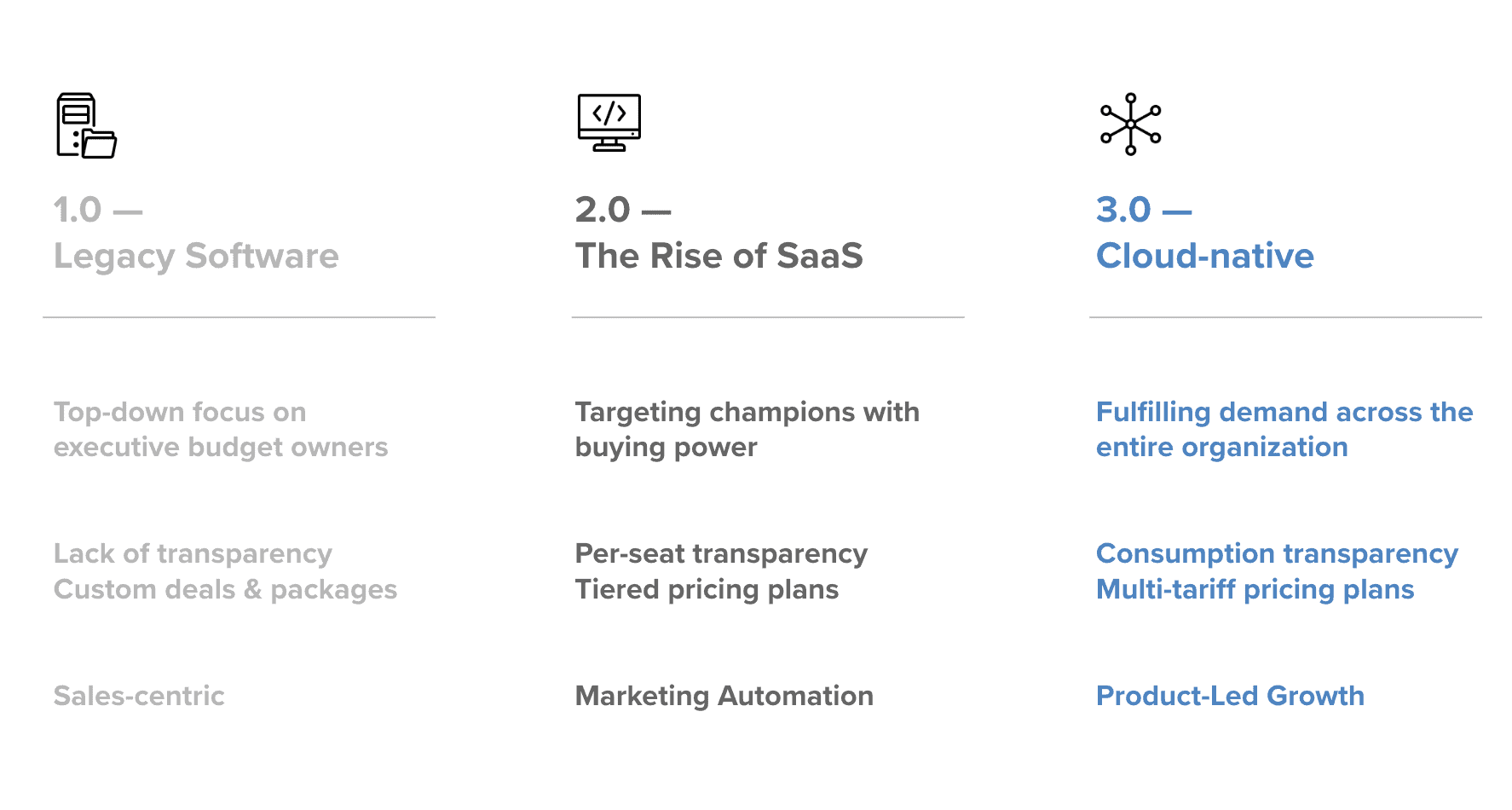Harsh Jawharkar is a growth leader and executive advisor who partners with investors, founders, and CXOs to shape and accelerate growth across all stages. In this article, he offers entrepreneurs a guide to product-led growth.
Every week I speak with founders and CEOs who are building exciting new B2B SaaS companies. They’ve established product-market fit, grown organically, and just raised capital. Then comes the big question: what’s my go-to-market strategy to build and scale this business?
That’s when I get the call. They’ve heard about the success that companies such as Atlassian and Slack have had with product-led growth (PLG) and want to know if they can employ the same approach. I walk each founder through the essentials of PLG, help them to understand whether or not it’s right for their business, and if it’s a fit, ultimately explain how they should build a PLG system.
After having many of these conversations, I realized that collecting my thoughts in a structured guide could help others who have the same questions. If you are an entrepreneur leading a B2B SaaS startup and you need to evaluate product-led growth as a go-to-market strategy, this article will help get you up to speed.
What is Product-led Growth (PLG)?
PLG is a go-to-market approach for growing a user base by allowing users to directly experience the value of a product’s features through a frictionless adoption and purchase flow. In PLG, user experience with the product itself – rather than sales outreach – is the primary driver for converting free evaluations into purchases and growth.
At a high level, PLG offers startups two primary benefits:
- Time to value – The sooner your customers interact with and use the product, the sooner you will fulfill all the promises and claims you’ve made via marketing. The longer it takes a customer to realize your product’s benefits, the higher the risk of losing that customer to a competitor’s solution or their existing one.
- Maximize benefit consumption – Once your customers experience the value you promise, your product needs to motivate them to use it at its maximum value. If they fail to reach their true usage threshold, you will end up with unfulfilled customer potential leading to flatter growth curves and eventual churn.
And PLG is more scalable than other go-to-market approaches. Businesses and their customers achieve these benefits through frictionless product evaluation, self-service purchase, seamless adoption, and viral adoption across teams.
How did PLG start?
To understand how PLG emerged, we have to look back. Over the past two decades, SaaS has largely displaced the previous era of on-premise software, most of which was sold with perpetual licenses, maintenance contracts, and a heavy reliance on field sales.
SaaS democratized software purchasing. A majority of SaaS companies rely on static plans or tiers to sell to specific executive personas (e.g. CIO, CTO, CMO, etc.). If they are unable to reach their persona through sales and marketing outreach, their growth stalls.
Today, a steady stream of cloud-born companies empower anyone at any level in an organization to quickly adopt a solution with frictionless purchase, seamless activation, and intelligent product guidance to expand their usage. Companies such as Slack, Atlassian, Twilio, and Dropbox pioneered PLG and they continue to iterate and improve it.

What are the defining characteristics of PLG?
While not exhaustive, these are the primary attributes of a mature PLG approach:
- Evaluation – clear product demo(s), trial or free version, transparent pricing and packaging
- Purchase – simple, self-service, no jumping through hoops, as easy as a credit card payment
- Adoption – guided onboarding, ongoing in-product activation, post-purchase education
- Engagement – features that encourage the growth of users within existing teams or expansion into other teams
What is not PLG?
It’s not uncommon for companies to mistakenly believe they are implementing a PLG approach. These are the tell-tale signs that they are not:
- No pricing or packaging published on the website
- Customer needs to contact someone as the only way to purchase the product
- No investment in a singular try-buy-adopt journey (onboarding, activation, engagement)
- Simply offering a time-based trial or free version (freemium) without investing in onboarding, expansion, and cross-team usage within the product itself
- Reliance on referral marketing incentives (such as credits, features, storage) for referring other users or customers
The business case for PLG
All entrepreneurs trying to grow their companies face the same challenges. They need to find where their demand is, build awareness and interest in those markets, and then convert that interest into new business. The typical channels they use to reach those prospects are highly competitive, increasingly expensive, and difficult to scale in a linear fashion. As a result, top-line growth through the typical channels becomes challenging. To achieve efficient and exponential top-line growth, companies need to look outside the traditional, hyper-competitive pools of demand (where everyone else is also fighting for attention). Enter PLG.
With product-led growth, startups can achieve low churn and highly cost-effective expansion. Especially valuable in lean times, PLG can act as a business growth engine that runs more efficiently than heavier sales-based models.
Here are the business outcomes that define successful PLG companies:
- High aggregate growth – overall increases in volume of customers, users, and revenue
- Low customer and user churn – preempt a leaky funnel as well as a leaky product
- High intra-expansion – for team-based products, PLG companies are able to successfully expand usage within the team or department of the initial adopter
- High inter-acquisition – PLG companies design the right cross-flow paths to expose adjacent teams and functions to the value of their product, driving expansion by acquiring new users and teams within the target customer
Is PLG Right for Your Startup?
To evaluate whether PLG is a fit for your company, consider the following core requirements and analyze if, how, and to what degree you can meet them before moving forward:
- Buyer persona – do target customers have the inclination to self-evaluate your product? For example, if an engineering manager can quickly enter their credit card info and onboard their team to evaluate your product, then PLG is a great fit for you. On the other hand if your target persona is a CIO, whose time is scarce, then PLG may not be a great fit for you because that buyer won’t have the time or inclination to try or buy your product themselves.
- Decision-making – does trying or buying your product require a series of steps across different functions (e.g. IT, procurement, finance, risk/compliance, etc.)? If your prospective customer needs to coordinate across and get multiple approvals from different departments, it will slow down their ability to try the product, making it a poor fit for PLG. On the other hand, if an individual employee is empowered to pick tools that address their specific needs, it frees them up to make quick decisions. If your product fits this profile, PLG is a good fit.
- Self-serve friction – how hard will it be to build and operate commerce systems that allow a buyer to quickly enroll in a trial or free version and then purchase the product without human intervention? PLG relies on this type of upgrade or purchase flow, which requires a system to record the statuses and process payment transactions for thousands of customers, at scale, in a performant and error-free way. This is a time-consuming and intensive undertaking. PLG may not be a good fit if you cannot build this type of high-velocity commerce system.
- Time to value – how long will it take for a user to start experiencing the benefits of the product? Will the learning curve delay a user’s realization of your product’s promise? For PLG to work, users need to be guided towards experiencing the usefulness of the product’s features as soon as possible. Certain products will have dependencies outside of the user’s control, such as complex data migrations, integrations with other systems, etc. For these types of products, PLG may not be the best fit because it will take considerable time and effort to help users realize the value of the product.
Note that adopting PLG does not mean:
- You can stop doing marketing (there is no “field of dreams”; your users won’t come just because you build a product)
- You get rid of your sales and customer success teams
- You don’t have to invest in any customer or user acquisition (i.e., performance marketing, demand generation, etc.)
If you answered yes to most of these questions, you may be ready for a deeper dive into the details of planning and implementing a PLG strategy. Those details will be covered in the second of this two-part series: “A Pragmatic Guide to Holistic, Scalable Product-led Growth.”
About the author: Harsh Jawharkar is a growth leader and executive advisor, partnering with investors, founders, and CXOs to shape and accelerate growth across all stages. Harsh has built and scaled a diverse array of marketing organizations to drive growth at category-defining SaaS companies like Atlassian, Slack, Narvar, and Zendesk. Harsh began his career in product development, combining his background in engineering and design to ship large-scale cloud products at companies like PayPal and Sapient.

